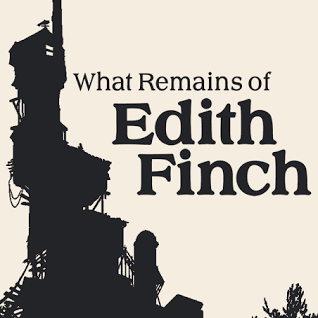What Remains of Edith Finch (referred to from now on as Edith Finch), created by Giant Sparrow, tells the story of Edith Finch returning to her family home to find the family secrets it holds. Like many other walking simulators, it is intended for audiences with minimal prior experience playing video games. Because it deals with serious themes like death, suicide, and mental health, I find it is best suited for young adults and up. I played the Switch port of the game.
The game has a richly-detailed environment that supports a powerful embedded story. It also puts players in the POV of various Finch family members, having them play through vignettes of each family member’s deaths. This creates a similarly powerful enacted story. However, what is most special about Edith Finch is the interaction between the embedded story and the enacted story. These elements blur into each other and create a unique experience that goes beyond simply embedding and enacting. I propose instead that Edith Finch presents a story that is embedded-in-enacting.
While embedded stories allow players to uncover clues in the environment and enacted stories allow players to act out a story, I argue that embedded-in-enacting stories embed clues about the story, themes, and characters in the player’s interactions with the game. The difference between embedded stories and embedded-in-enacting stories is subtle, to be sure, but powerful enough that the two experiences are wholly separate.
Each vignette teaches the player something new about the finch family house. The player usually progresses through the game by utilizing information they learn from the previous vignette. For example, Barb’s vignette teaches the player that a basement key is hidden in the music box, and even though the player can interact with the music box as soon as they enter the house, they are only given the option to retrieve the key after Barb’s vignette. Furthermore, each story recontextualizes details about the house. When I first approached the house, I peeked through a hole in the backyard fence to see a swing wrapped almost all the way around a tree branch. This detail seemed innocuous until I played through Calvin’s vignette, in which he swings “all the way around” and is flung off of the cliff the swing overlooks. The swing suddenly went from mundane to tragic. Edith Finch is packed with details like these that take on extra meaning after you experience the stories of the previous Finch family members. The enacted and embedded stories cleverly support one another to create a beautifully cohesive experience.
However, the interaction between embedded and enacted stories supports the game’s narrative in such a way as to produce a wholly unique experience, and this is what I call embedded-in-enacting. For example, Barb’s vignette takes the player into the basement in pursuit of a “home-invader”, who really turns out to be Barb’s boyfriend playing a prank. However, the vignette ends with Barb disappearing and only her ear being found in the music box. This detail was morbid enough to make Edith’s subsequent trip into the basement much creepier than it otherwise would have been. We then play through Walter’s vignette, which shows him hiding away in a bunker below the house out of fear. He chooses to hide away because he was witness to Barb’s death. The fear I felt descending into the basement had the same source as the fear that drove Walter into his bunker. The game recontextualizes the environment in a way that conveys narrative information, and this is the unique experience that I argue is the embedded-in-enacting story.
The embedded-in-enacting story doesn’t just occur on the vignette-to-vignette level either, it frames the overarching narrative. The conflict at the core of the story is between Edie and Dawn, Edith’s great-grandmother and mother. Edie believes that her family’s stories need to be shared, but Dawn wants to hide the stories away to protect Edith. Because we learn so much about the house through the vignettes, we get to see exactly why Edie believes what she believes – we can only fully appreciate the world by hearing the stories of its past. We also get to experience exactly why Dawn believes what she believes – what we learn from the stories of the past isn’t always happy. Frequently it’s tragic.
The game isn’t shy about picking a side in this conflict. The player has to uncover the family’s stories, otherwise there is no game. Perhaps stories can be tragic, but the game shows us over and over that running from tragedy, trying to hide from it, or trying to fight it gets us nowhere. We have to face tragedy head-on and choose to live in spite of it. As Edith says at the game’s conclusion, “I don’t want you to be sad that I’m gone. I want you to be amazed that any of us ever had a chance to be here at all.”



